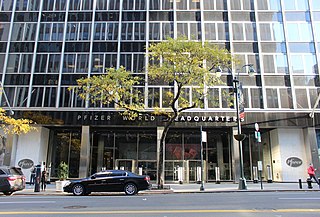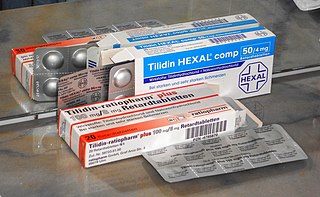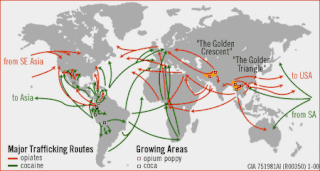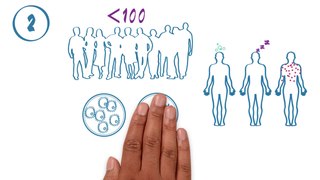


Purinones (oxopurines) are derivatives of purine which have a substituted keto group. [1]
Most are divided into 2 families:
Purinones form the central core of numerous pharmaceutical drugs used in a variety therapeutic areas. [2]



Purinones (oxopurines) are derivatives of purine which have a substituted keto group. [1]
Most are divided into 2 families:
Purinones form the central core of numerous pharmaceutical drugs used in a variety therapeutic areas. [2]

Cocaine is a tropane alkaloid and stimulant drug obtained primarily from the leaves of two coca species, Erythroxylum coca and Erythroxylum novogranatense. It is most commonly used as a recreational drug and euphoriant. After extraction from coca leaves, cocaine may be snorted, heated until sublimated and then inhaled, or dissolved and injected into a vein. Mental effects may include an intense feeling of happiness, sexual arousal, loss of contact with reality, or agitation. Physical symptoms may include a fast heart rate, sweating, and dilated pupils. High doses can result in high blood pressure or body temperature. Effects begin within seconds to minutes of use and last between five and ninety minutes.

3,4-Methyl

The United States Food and Drug Administration is a federal agency of the Department of Health and Human Services. The FDA is responsible for protecting and promoting public health through the control and supervision of food safety, tobacco products, dietary supplements, prescription and over-the-counter pharmaceutical drugs (medications), vaccines, biopharmaceuticals, blood transfusions, medical devices, electromagnetic radiation emitting devices (ERED), cosmetics, animal foods & feed and veterinary products.

Heroin, also known as diacetylmorphine and diamorphine among other names, is an opioid used as a recreational drug for its euphoric effects. Medical grade diamorphine is used as a pure hydrochloride salt which is distinguished from black tar heroin, a variable admixture of morphine derivatives—predominantly 6-MAM (6-monoacetylmorphine), which is the result of crude acetylation during clandestine production of street heroin. Diamorphine is used medically in several countries to relieve pain, such as during childbirth or a heart attack, as well as in opioid replacement therapy.

Lysergic acid diethylamide (LSD), also known colloquially as acid, is a hallucinogenic drug. Effects typically include altered thoughts, feelings, and awareness of one's surroundings. Many users have visual or auditory hallucinations. Dilated pupils, increased blood pressure, and increased body temperature are typical. Effects typically begin within half an hour and can last for up to 20 hours. It is used mainly as a recreational drug or for spiritual reasons.

Oxycodone, sold under the brand names Roxicodone and OxyContin among others, is an opioid medication used for treatment of moderate to severe pain. It is highly addictive and is commonly used recreationally by people who have an opioid use disorder. It is usually taken by mouth, and is available in immediate-release and controlled-release formulations. Onset of pain relief typically begins within fifteen minutes and lasts for up to six hours with the immediate-release formulation. In the United Kingdom, it is available by injection. Combination products are also available with paracetamol (acetaminophen), ibuprofen, naloxone, naltrexone, and aspirin.

Pharmacology is a branch of medicine, biology and pharmaceutical sciences concerned with drug or medication action, where a drug may be defined as any artificial, natural, or endogenous molecule which exerts a biochemical or physiological effect on the cell, tissue, organ, or organism. More specifically, it is the study of the interactions that occur between a living organism and chemicals that affect normal or abnormal biochemical function. If substances have medicinal properties, they are considered pharmaceuticals.

Pfizer Inc. is an American multinational pharmaceutical and biotechnology corporation headquartered on 42nd Street in Manhattan, New York City. The name of the company commemorates its co-founder, Charles Pfizer (1824-1906).

Fentanyl, also spelled fentanil, is a powerful opioid used as a pain medication and together with other medications for anesthesia. It is also used as a recreational drug, sometimes mixed with heroin, methamphetamine, or cocaine. It has a rapid onset and its effects generally last under two hours. Medically, it is used by injection, nasal spray, skin patch, or absorbed through the cheek (transmucosal) as a lozenge or tablet.

A medication is a drug used to diagnose, cure, treat, or prevent disease. Drug therapy (pharmacotherapy) is an important part of the medical field and relies on the science of pharmacology for continual advancement and on pharmacy for appropriate management.

The illegal drug trade or drug trafficking is a global black market dedicated to the cultivation, manufacture, distribution and sale of prohibited drugs. Most jurisdictions prohibit trade, except under license, of many types of drugs through the use of drug prohibition laws.

A drug overdose is the ingestion or application of a drug or other substance in quantities greater than are recommended. Typically it is used for cases when a risk to health will potentially result. An overdose may result in a toxic state or death.

The war on drugs is a global campaign, led by the U.S. federal government, of drug prohibition, military aid, and military intervention, with the aim of reducing the illegal drug trade in the United States. The initiative includes a set of drug policies that are intended to discourage the production, distribution, and consumption of psychoactive drugs that the participating governments and the UN have made illegal. The term was popularized by the media shortly after a press conference given on June 18, 1971, by President Richard Nixon—the day after publication of a special message from President Nixon to the Congress on Drug Abuse Prevention and Control—during which he declared drug abuse "public enemy number one". That message to the Congress included text about devoting more federal resources to the "prevention of new addicts, and the rehabilitation of those who are addicted", but that part did not receive the same public attention as the term "war on drugs". However, two years prior to this, Nixon had formally declared a "war on drugs" that would be directed toward eradication, interdiction, and incarceration. Today, the Drug Policy Alliance, which advocates for an end to the War on Drugs, estimates that the United States spends $51 billion annually on these initiatives.

Cannabis, also known as marijuana among other names, is a psychoactive drug from the Cannabis plant used primarily for medical and recreational purposes. Tetrahydrocannabinol (THC) is the main psychoactive component of cannabis, which is one of the 483 known compounds in the plant, including at least 65 other cannabinoids, including cannabidiol (CBD). Cannabis can be used by smoking, vaporizing, within food, or as an extract.

Joaquín Archivaldo Guzmán Loera, commonly known as "El Chapo" because of his 168 cm stature, is a Mexican former drug lord and former leader of the Sinaloa Cartel, an international crime syndicate. He is considered to have been the most powerful drug trafficker in the world.

The Mexican drug war is the Mexican theater of the global war on drugs, as led by the U.S. federal government, that has resulted in an ongoing asymmetric low-intensity conflict between the Mexican government and various drug trafficking syndicates. When the Mexican military began to intervene in 2006, the government's principal goal was to reduce drug-related violence. The Mexican government has asserted that their primary focus is on dismantling the powerful drug cartels, and on preventing drug trafficking demand along with the U.S. functionaries.

A drug is any substance that causes a change in an organism's physiology or psychology when consumed. Drugs are typically distinguished from food and substances that provide nutritional support. Consumption of drugs can be via inhalation, injection, smoking, ingestion, absorption via a patch on the skin, suppository, or dissolution under the tongue.

Methamphetamine is a potent central nervous system (CNS) stimulant that is mainly used as a recreational drug and less commonly as a second-line treatment for attention deficit hyperactivity disorder and obesity. Methamphetamine was discovered in 1893 and exists as two enantiomers: levo-methamphetamine and dextro-methamphetamine. Methamphetamine properly refers to a specific chemical, the racemic free base, which is an equal mixture of levomethamphetamine and dextromethamphetamine in their pure amine forms. It is rarely prescribed over concerns involving human neurotoxicity and potential for recreational use as an aphrodisiac and euphoriant, among other concerns, as well as the availability of safer substitute drugs with comparable treatment efficacy. Dextromethamphetamine is a stronger CNS stimulant than levomethamphetamine.

The Sinaloa Cartel, also known as the CDS, the Guzmán-Loera Organization, the Pacific Cartel, the Federation and the Blood Alliance, is a large international drug trafficking, money laundering, and organized crime syndicate established during the late 1980s. The cartel is primarily based in the city of Culiacán, Sinaloa, with operations in the Mexican states of Baja California, Durango, Sonora, and Chihuahua. The "Federation" was partially splintered when the Beltrán-Leyva brothers broke apart from the Sinaloa Cartel. The United States Intelligence Community considers the Sinaloa Cartel to be one of the most powerful drug trafficking organizations in the world, making it perhaps even more influential and capable than the infamous Medellín Cartel of Colombia during its prime in the 1980s and early 1990s. It has repeatedly been said to be one of the world's strongest criminal organizations and indisputably the most powerful in Mexico since at least the late 2000s and early 2010s by various sources including the Los Angeles Times.

The phases of clinical research are the stages in which scientists conduct experiments with a health intervention to obtain sufficient evidence for a process considered effective as a medical treatment. For drug development, the clinical phases start with testing for safety in a few human subjects, then expand to many study participants to determine if the treatment is effective. Clinical research is conducted on drug candidates, vaccine candidates, new medical devices, and new diagnostic assays.